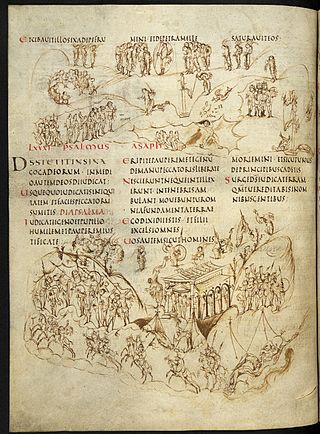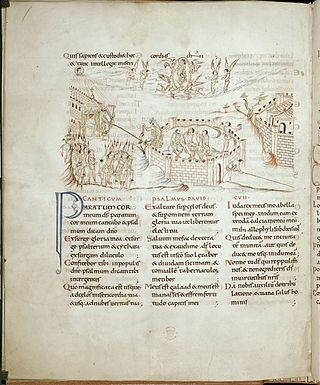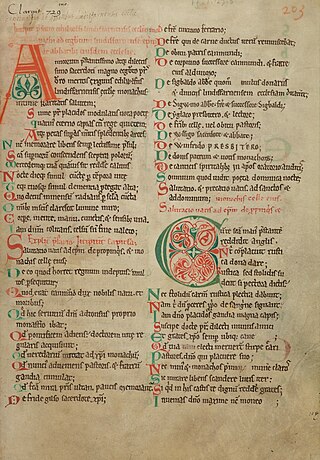
The Hereford Gospels is an 8th-century illuminated manuscript gospel book in insular script (minuscule), with large illuminated initials in the Insular style. This is a very late Anglo-Saxon gospel book, which shares a distinctive style with the Caligula Troper. An added text suggests this was in the diocese of Hereford in the 11th century.
The Old English Bible translations are the partial translations of the Bible prepared in medieval England into the Old English language. The translations are from Latin texts, not the original languages.

The Psychomachia is a poem by the Late Antique Latin poet Prudentius, from the early fifth century AD. It has been considered to be the first and most influential "pure" medieval allegory, the first in a long tradition of works as diverse as the Romance of the Rose, Everyman and Piers Plowman; however, a manuscript discovered in 1931 of a speech by the second-century academic skeptic philosopher Favorinus employs psychomachia, suggesting that he may have invented the technique.

The Echternach Gospels were produced, presumably, at Lindisfarne Abbey in Northumbria around the year 690. This location was very significant for the production of Insular manuscripts, such as the Durham Gospels and the Lindisfarne Gospels. The scribe of the Durham Gospels is believed to have created the Echternach Gospels as well. The Echternach Gospels are now in the collection of France's Bibliothèque Nationale in Paris.

British Library, MS Cotton Tiberius C. II, or the Tiberius Bede, is an 8th-century illuminated manuscript of Bede's Historia ecclesiastica gentis Anglorum. It is one of only four surviving 8th-century manuscripts of Bede, another of which happens to be MS Cotton Tiberius A. XIV, produced at Monkwearmouth–Jarrow Abbey. As such it is one of the closest texts to Bede's autograph. The manuscript has 155 vellum folios. This manuscript may have been the Latin text on which the Alfredian Old English translation of Bede's Ecclesiastical History was based. The manuscript is decorated with zoomorphic initials in a partly Insular and partly Continental style.

The Vespasian Psalter is an Anglo-Saxon illuminated psalter decorated in a partly Insular style produced in the second or third quarter of the 8th century. It contains an interlinear gloss in Old English which is the oldest extant English translation of any portion of the Bible. It was produced in southern England, perhaps in St. Augustine's Abbey or Christ Church, Canterbury or Minster-in-Thanet, and is the earliest illuminated manuscript produced in "Southumbria" to survive.

Pseudo-Apuleius is the name given in modern scholarship to the author of a 4th-century herbal known as Pseudo-Apuleius Herbarius or Herbarium Apuleii Platonici. The author of the text apparently wished readers to think that it was by Apuleius of Madaura (124–170 CE), the Roman poet and philosopher, but modern scholars do not believe this attribution. Little or nothing else is known of Pseudo-Apuleius.

The Utrecht Psalter is a ninth-century illuminated psalter which is a key masterpiece of Carolingian art; it is probably the most valuable manuscript in the Netherlands. It is famous for its 166 lively pen illustrations, with one accompanying each psalm and the other texts in the manuscript. The precise purpose of these illustrations, and the extent of their dependence on earlier models, have been matters of art-historical controversy. The psalter spent the period between about 1000 to 1640 in England, where it had a profound influence on Anglo-Saxon art, giving rise to what is known as the "Utrecht style". It was copied at least three times in the Middle Ages. A complete facsimile edition of the psalter was made in 1875, and another in 1984 (Graz).

The Athelstan Gospels, or British Library, Cotton MS Tiberius A. ii is a late 9th or early 10th-century Ottonian illuminated Gospel book which entered England as a gift to King Athelstan, who in turn offered it to Christ Church, Canterbury. It is also referred to as the Coronation Gospels on account of an early modern tradition that it had been used as an oath-book at English coronations.

The Psalter of Oswald also called the Ramsey Psalter is an Anglo-Saxon illuminated psalter of the last quarter of the tenth century. Its script and decoration suggest that it was made at Winchester, but certain liturgical features have suggested that it was intended for use at the Benedictine monastery of Ramsey Abbey in Huntingdonshire, or for the personal use of Ramsey's founder St Oswald.

The Harley Psalter is an illuminated manuscript of the second and third decades of the 11th century, with some later additions. It is a Latin psalter on vellum, measures 380 x 310 mm and was probably produced at Christ Church, Canterbury. The most likely patron of such a costly work would have been the Archbishop of Canterbury at the time, possibly Æthelnoth, who was consecrated in 1020 and remained at Canterbury until 1038.

De abbatibus is a Latin poem in eight hundred and nineteen hexameters by the ninth-century Anglo-Saxon monk Æthelwulf (Ædiluulf), a name meaning "noble wolf", which the author sometimes Latinises as Lupus Clarus. It recounts the history of his monastery from its foundation through its six first abbots and ending with Æthelwulf's two visions. It is addressed to the Bishop of Lindisfarne, Ecgberht, and dates to between 803 and 821.

The Cleopatra Glossaries are three Latin-Old English glossaries all found in the manuscript Cotton Cleopatra A.iii. The glossaries constitute important evidence for Old English vocabulary, as well as for learning and scholarship in early medieval England generally. The manuscript was probably written at St Augustine's, Canterbury, and has generally been dated to the mid-tenth century, though recent work suggests the 930s specifically.
The Leiden Glossary is a glossary contained in a manuscript in Leiden University Library in the Netherlands, Voss. Lat. Q. 69. The lemmata (headwords) come from "a range of biblical, grammatical, and patristic texts". It is based on an Anglo-Saxon exemplar, and was prepared c. 800 in the Abbey of Saint Gall in modern-day Switzerland.
The Épinal-Erfurt glossary is a glossary of Old English. It survives in two manuscripts. It has been described as "the earliest body of written English", and is thought to have been compiled at Malmesbury for Aldhelm.
The Old English Boethius is an Old English translation/adaptation of the sixth-century Consolation of Philosophy by Boethius, dating from between c. 880 and 950. Boethius's work is prosimetrical, alternating between prose and verse, and one of the two surviving manuscripts of the Old English translation renders the poems as Old English alliterative verse: these verse translations are known as the Metres of Boethius.
Gernot Wieland is an emeritus professor at the University of British Columbia, who specializes in the Anglo-Saxon period, specifically glosses in Anglo-Saxon manuscripts, relations between Anglo-Saxon scholars and their continental counterparts, and the Latin literature written by Anglo-Saxons.











